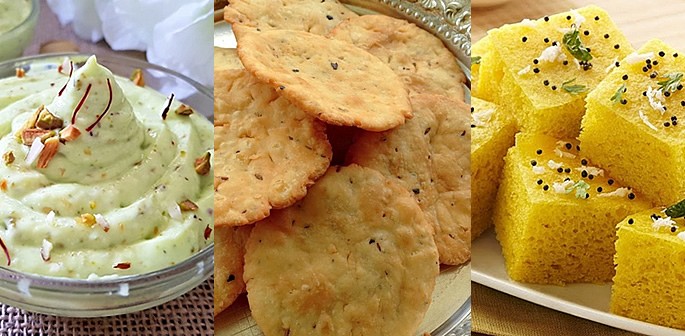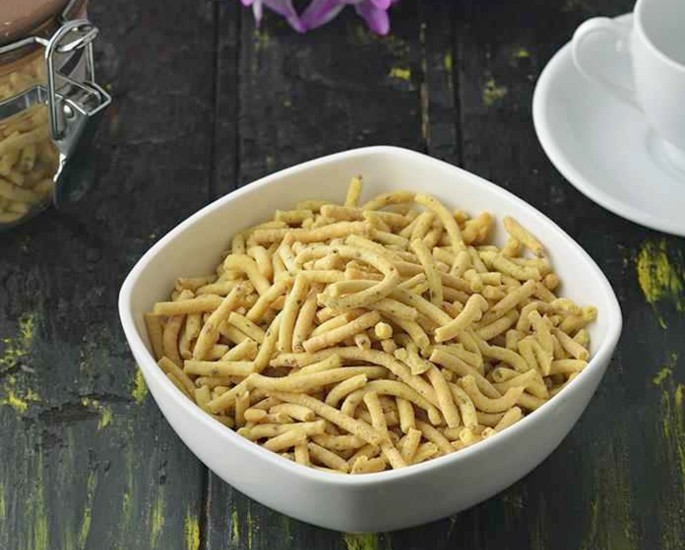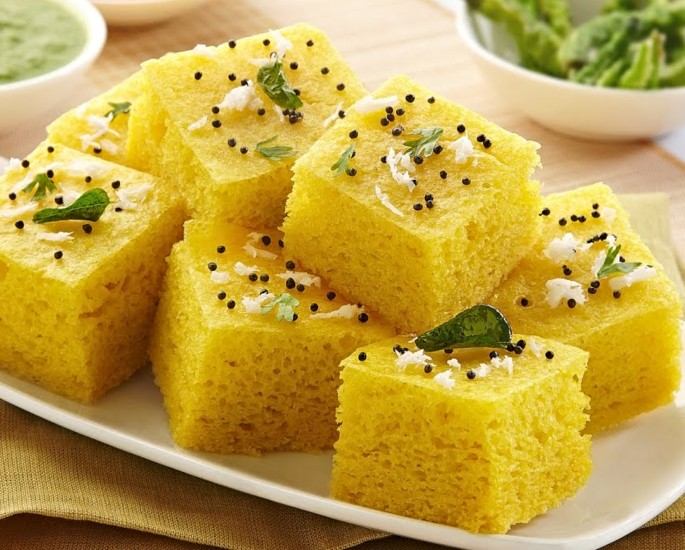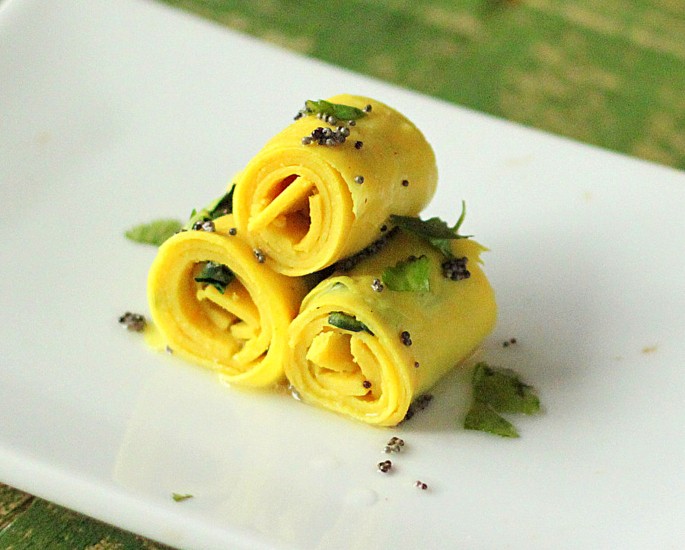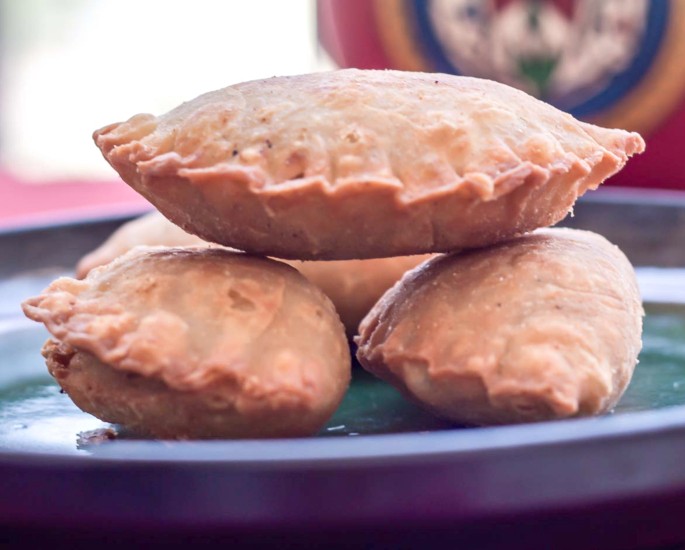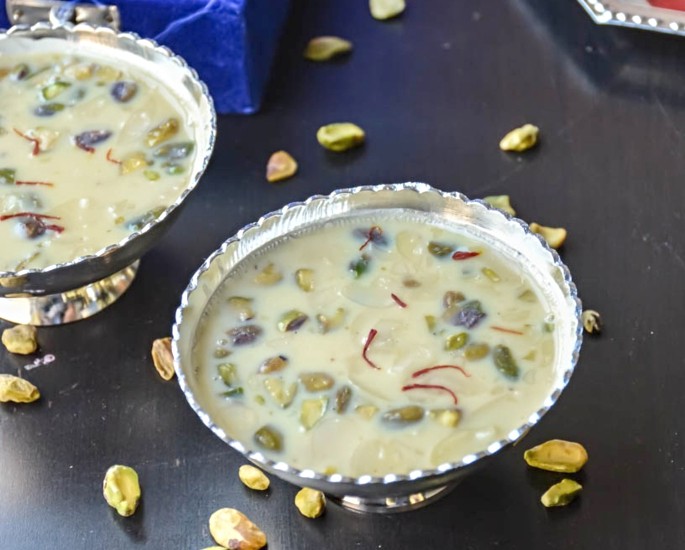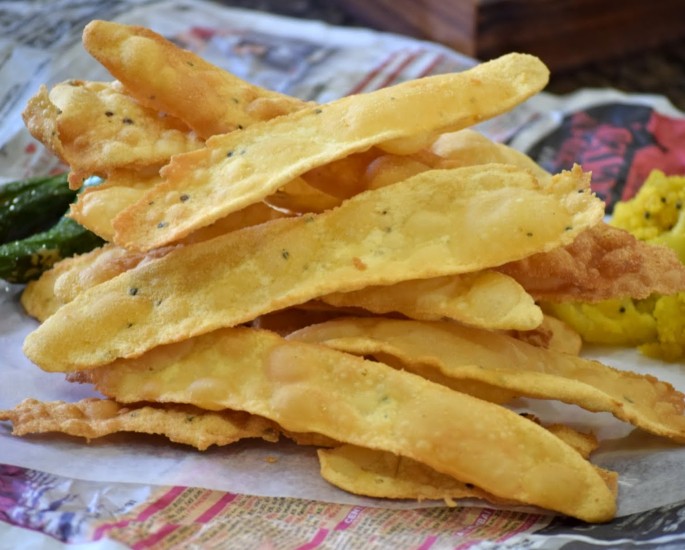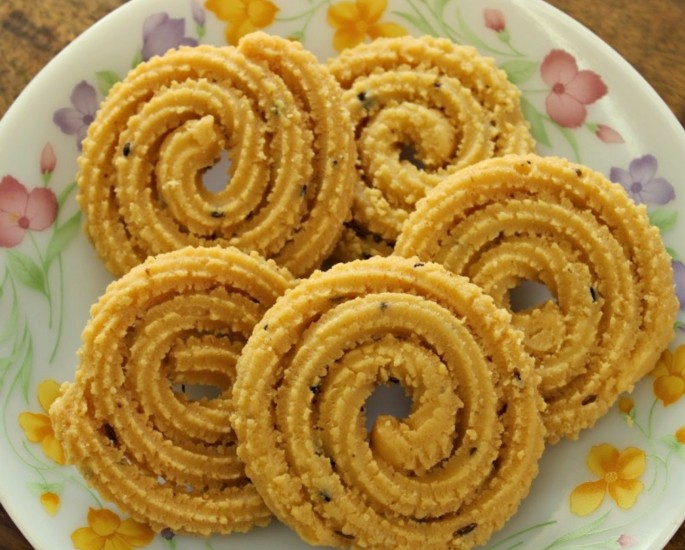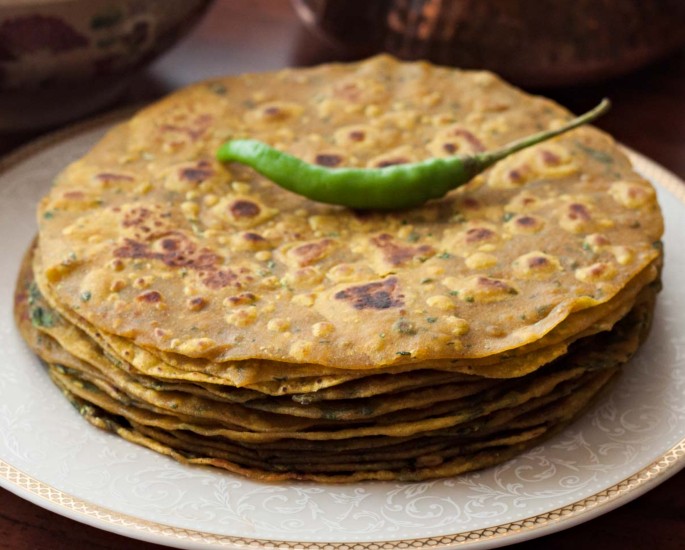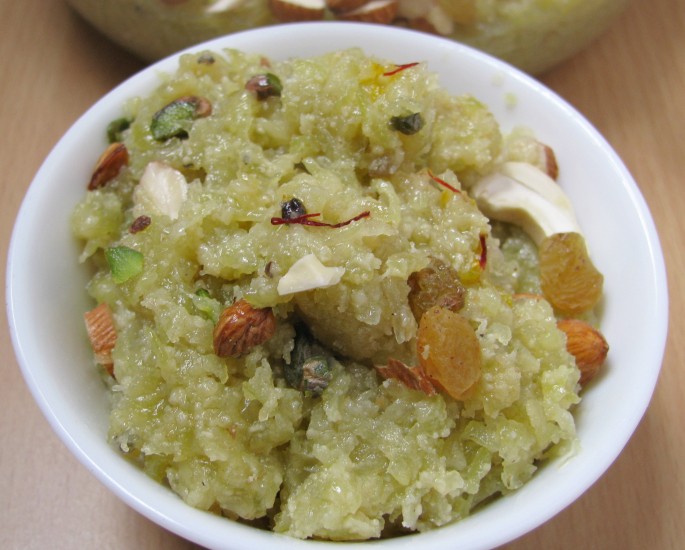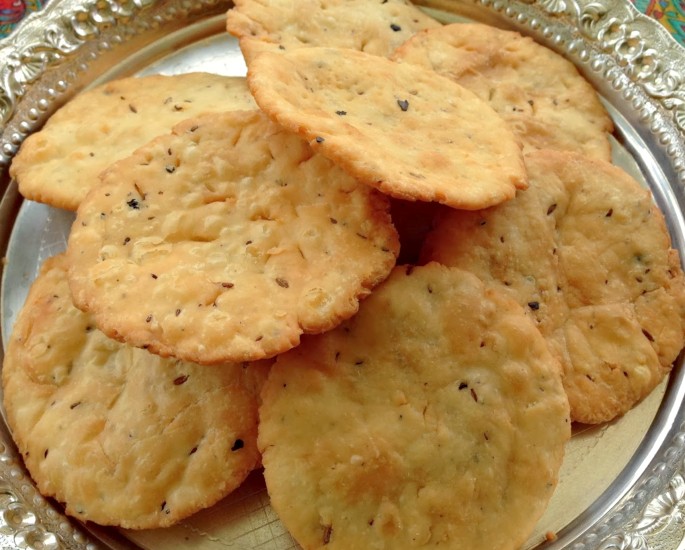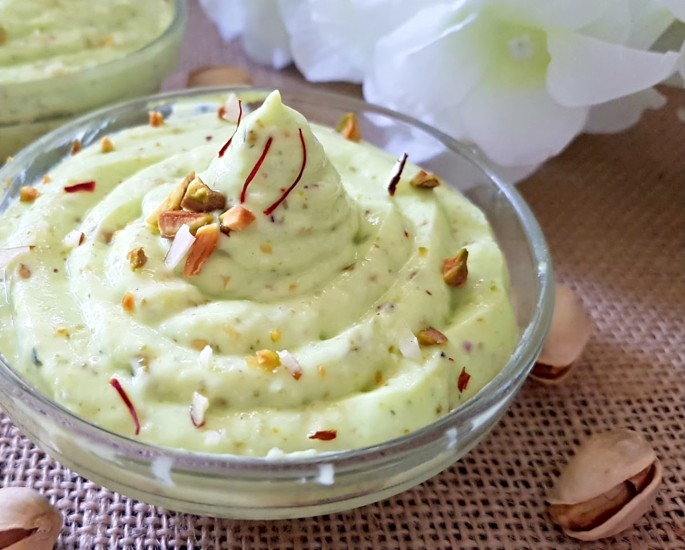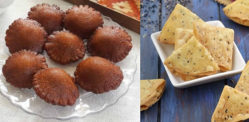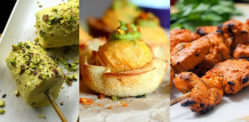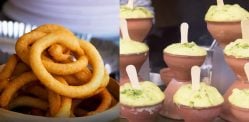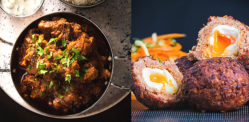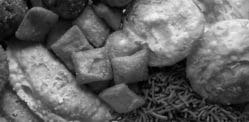The carom seeds and asafoetida give the gathiya a flavourful and aromatic kick.
Indian sweets and savoury snacks are some of the most flavourful foods to have, so why not try Gujarati ones.
Gujarati snacks come in a wide range to suit all preferences. From savoury bites which have a hint of spice to sweet dishes which are silky smooth, they have a number of tasty choices.
Many of these sweets and snacks can be enjoyed during any time of the day and are suitable for special occasions.
When making Gujarati sweets and savoury snacks, the idea is to ensure that enough is made for everyone to enjoy.
These snacks and sweets are fairly easy to make but some take time to prepare so it is best to make them with some planning.
With these recipes, for both savoury and sweet dishes, you will be able to make some wonderful foods which are well-known to Gujarati people and will be a fantastic addition to your meals.
Gathiya
Gathiya is a crunchy and savoury snack which has been enjoyed by Gujarati people for generations. Its popularity has grown to other parts of Indian and the rest of the world.
The tasty snack uses gram flour but the carom seeds and asafoetida give the gathiya a flavourful and aromatic kick.
The papad khar (alkaline salt) is essential as enhances the crispiness of the gathiya.
It is a delicious snack which is best enjoyed with a hot cup of tea and delicious sweets.
Ingredients
- 1½ cups gram flour
- ½ tsp papad khar (alkaline salt)
- 1 tsp salt
- ½ tsp asafoetida
- 1 tsp carom seeds
- 3 tbsp hot oil
- Oil, for greasing and deep-frying
- 2 tbsp water
Method
- In a saucepan, heat the water and then add the papad khar and salt. Cook on a medium heat and mix well for a minute or until the papad khar has dissolved. Once done, set aside.
- In a deep bowl, add gram flour, asafoetida, carom seeds, hot oil and the papad khar mixture. Knead into a firm dough. Cover and set aside for 15 minutes.
- Grease your hands slightly with a little oil to prevent sticking and knead the dough to smoothen it.
- Grease a sev press using some oil then press the dough into it and cover with the lid.
- Heat oil in a non-stick pan and place the sev press above the oil at a distance. Turn the sev press handle so that the dough drops into the oil.
- Move the sev press in a circular motion at the same time as turning the sev press handle in a circular motion.
- Deep-fry the gathiya in batches on a medium flame until they turn light yellow and crisp while turning at intervals.
- Drain on kitchen paper and leave to cool completely.
- Break into pieces then serve or store in an air-tight container.
This recipe was inspired by Tarla Dalal.
Dhokla
Dhokla is one of the most popular Gujarati snacks and is enjoyed across the country especially as it is made in various ways.
The soft, spongy texture of each piece of dhokla tastes even better with the tadka, or tempering, which is widely used in Indian cuisine.
This particular recipe makes dhokla by steaming, which makes them even softer as well as healthier.
It is best enjoyed how it is, but you can serve it along with some green chutney for that extra punch of flavour.
Ingredients
- 1 cup Gram flour
- 1 tbsp citric acid
- Salt, to taste
- 1 tbsp sugar
- A pinch of turmeric
- 1 tbsp baking powder (dissolved in water)
- Water, to make a batter
For the Tadka
- 1 tbsp oil
- ½ tbsp mustard seeds
- 1 Dried red chilli
- 8 Curry leaves
Method
- Mix gram flour, citric acid, salt, turmeric and sugar in a bowl. Add enough water to make a smooth batter with a medium consistency.
- Dissolve the baking powder in water and pour it into the mixture.
- Grease the steaming tin with a little oil and pour the mixture into it. Steam for 20 minutes or until cooked.
- In a frying pan, add oil, mustard seeds, curry leaves and red chillies and let it splutter to create the tadka.
- Pour the tadka over the cooked dhokla, cut into pieces and serve.
This recipe was inspired by NDTV Food.
Khandvi
This snack is a delicious treat to eat but can take a bit of practice to make. The rolled gram flour and yoghurt batter is excellent, especially as the chillies provide that hint of spice.
The combination of ingredients, as well as the rolled up appearance, make it an appealing snack.
It is commonly eaten as an appetiser and is available across India. Many people choose to buy it from the shop rather than making it at home because of the difficulty when making it.
It is best to prepare this snack with plenty of planning to ensure you create an authentic Gujarati snack to enjoy. Serve it with garlic chutney for extra flavour.
Ingredients
- 1¼ cups Gram flour
- 1 cup Yoghurt
- 2 Green chillies
- ½ tsp turmeric powder
- 1 tbsp lemon juice
- ½ cup water
- A pinch of asafoetida
- 1 tsp mustard seeds
- 1-inch piece of ginger
- 2 tsp coconut
- 4 tbsp oil
- Salt to taste
- Coriander leaves, chopped
Method
- Sift the gram flour into a bowl. Grind the ginger and green chillies together to make a paste. Meanwhile, grease a tabletop with a little oil.
- Mix together yoghurt and water to make a buttermilk.
- Mix the gram flour with ginger-chilli paste, salt, turmeric paste, lemon juice and buttermilk. Stir continuously until no lumps remain.
- Cook the mixture on a medium heat in a thick bottomed pan, stirring constantly until it becomes a thick batter.
- While the batter is still hot, spread portions of the mixture over the table top as thinly as possible.
- When cooled, cut into strips and tightly roll. Heat a little oil in a frying pan and add the asafoetida and mustard seeds.
- After they splutter, pour over the khandvi pieces. Garnish with coconut and coriander leaves.
This recipe was inspired by Sanjeev Kapoor.
Ghughra
It is a simple snack which are just pockets of pastry filled with dried fruit or nuts and are deep-fried to a golden finish.
This pastry snack tastes even more delicious when served hot, but also taste good after a week when stored in a container.
They are often made during special occasions like Diwali or Holi but can be enjoyed at any time of the year.
This particular recipe is filled with almonds, pistachios and dates for a combination of flavours and textures.
Ingredients
- 3 cups All-purpose flour
- ¼ cup ghee
- ¼ tsp salt
For the Filling
- ¼ cup Pistachios, coarsely powdered
- ¼ cup Cashew nuts, coarsely powdered
- ½ cup Desiccated coconut powder
- ¼ cup Almonds, coarsely powdered
- ¼ cup Dates, finely chopped
- 2 tsp cardamom powder
- ¼ cup Raisins
Method
- Combine the flour, ghee and salt into a large bowl. Work the ghee into the flour with your fingers until the mixture becomes coarse.
- Sprinkle a little water to form a ball which holds together and is smooth.
- Add a little water to prevent the dough from going soggy. Cover and leave to rest for one hour.
- To make the filling, crush all the nuts in a food processor and divide the dough into 20 equal portions. Keep a small bowl with water aside.
- On a floured surface, roll each piece of dough into three-inch diameter circles.
- Place a teaspoon of filling into one half of the circle. Wet your fingers and spread a little water around the edges of the circle.
- Gently fold it into a semi-circle and seal the edges by pressing down. Make sure that it is well-sealed.
- Decorate the edges of the ghughra by twisting the dough to form a pattern.
- Heat oil on a medium heat. When hot, place each ghughra into the oil. Turn in the oil as they begin to float to the top.
- Cook in batches of five and cook until they become golden brown on each side. Remove from the oil, drain on kitchen paper and serve.
This recipe was inspired by Archana’s Kitchen.
Basundi
Basundi is a popular Gujarati sweet dish and is a rich and creamy treat made of thickened milk, similar to the North Indian rabdi.
Mixed nuts such as almonds and pistachios add crunch to this delicious sweet dish. It can be served warm or chilled and is delicious alongside deep-fried puris.
It is an authentic recipe which can be modernised by adding pineapple for a more fruity flavour.
Basundi takes time to cook but will be worth the effort once you’re left with a thick, creamy dish.
Ingredients
- 6½ cups Full-fat milk
- ½ cup Sugar
- ½ tsp cardamom powder
- 2 tsp almonds, sliced
- 2 tsp cashew nuts, chopped
- ¼ cup Water
For the Garnish
- 2 tsp almond slivers
- 2 tsp pistachio slivers
- A few saffron strands
Method
- Rinse a deep non-stick pan with water and simmer for three minutes. This prevents the milk from burning as the water forms a protective layer.
- Add the milk and bring to a boil on a high heat, stirring occasionally. Reduce the flame and cook for 45 minutes while stirring occasionally.
- Add the sugar and cook for a further 40 minutes while stirring every few minutes. Stir in the cardamom powder and cook for another 10 minutes.
- Increase the heat to medium and add the sliced almonds, cashew nuts. Cook for 10 minutes.
- Transfer to a deep bowl and cool completely. After it reaches room temperature, refrigerate and serve chilled with garnishes of saffron, almond and pistachio slivers.
This recipe was inspired by Tarla Dalal.
Fafda
Fafda is a very popular Gujarati snack which uses gram flour, like gathiya. The deep-fried snack is rectangular in shape and is golden in colour.
The carom seeds and red chilli powder adds a subtle hint of heat to the snack.
Fafda is a fan favourite among Gujarati people and is made for special occasions. It is also very popular as a breakfast item for people in India.
The crispiness and flavours coming from fafda make it a tasty snack to make at home.
Ingredients
- 2 cups Gram flour
- ¼ tsp turmeric
- ½ tsp red chilli powder
- Salt, to taste
- ¼ tsp carom seeds
- ¼ tsp baking soda
- 2 tbsp oil
- Water, to make the dough
- Vegetable oil, for deep-frying
Method
- In a large bowl, add the gram flour, turmeric, chilli powder, carom seeds, baking soda and salt. Mix together.
- Add two tablespoons of oil and mix well. Add water to make into a dough and knead for five minutes or until the dough becomes soft and smooth.
- Coat the dough in one teaspoon of oil then cover with a damp cloth and rest for 30 minutes.
- Knead for one further minute to ensure the dough is soft. Divide the dough into small balls.
- Make a cylindrical shape with each one then place onto a wooden board. Stretch it thin then gently scrape off the board with a knife.
- Heat oil in a wok on a medium heat. When hot place the fafdas into the oil making sure to not overcrowd them. Fry for one minute until they turn golden in colour and crispy.
- Remove from the oil once done and drain on kitchen paper.
- Serve with green chutney or kadhi.
This recipe was inspired by Hebbar’s Kitchen.
Chakri
The savoury snack is typically made from a number of flours to help give it the unique texture that it is known for.
It is known as “Chakri” in Gujarati but it is also called “Chakli” is other parts of India.
It also has a noticeable crunch when taking a bite but when done so, a plethora of flavours come out.
The slight bitterness from the cumin combines well with the hint of red chilli powder.
It is deep-fried until it reaches a perfect golden colour and can be enjoyed on its own.
Ingredients
- 1 cup Rice flour
- ½ cup All-purpose flour
- ½ tsp red chilli powder
- ¼ tsp asafoetida
- ¾ tsp cumin seeds
- 1 tbsp unsalted butter, at room temperature
- ¼ cup Yoghurt
- ¼ tsp turmeric powder
- Salt, to taste
- Oil, for deep-frying
- ¼ cup Warm water
Equipment
- Chakri maker
Method
- In a mixing bowl, mix together rice flour, all-purpose flour, turmeric, chilli powder, cumin seeds and salt. Mix together.
- Add butter and asafoetida, then roughly mix. Add yoghurt and mix together. Slowly pour in the water and knead.
- Knead together to make into a smooth dough. Take the star mould and attach it to the chakri maker. Grease it with some oil to prevent it from sticking.
- Make the dough into a cylindrical shape and place it inside the chakri maker.
- Prepare the chakris by making spiral shapes onto a wet cloth. Seal the ends so that they do not fall apart.
- Meanwhile, heat a wok with oil on a medium heat.
- Take each chakri and gently place into the hot oil. Fry until they turn golden brown then flip. Cook until crispy on both sides.
- Remove from the oil and drain on kitchen paper.
This recipe was inspired by Hebbar’s Kitchen.
Methi Thepla
This is a must try Gujarati snack which is lightly spiced and like a paratha is prepared using wheat flour, fenugreek leaves and a number of spices.
Making the perfect dough is essential to getting a mouth-watering taste as it has the right balance of spices and fenugreek leaves.
The ginger-garlic paste adds a little spice and aroma to the flat-bread, while turmeric gives it that golden colour.
It is also quite simple to make, taking approximately 30 minutes to make.
Ingredients
- 1 cup Wheat flour
- ½ cup Fenugreek leaves, finely chopped
- 1 tbsp yoghurt
- 1 tsp ginger-garlic paste
- ½ tsp turmeric powder
- 1 tsp coriander powder
- ½ cup Wheat flour, for dusting
- 1 tsp red chilli powder
- 3 tbsp coriander leaves, finely chopped
- 2 tsp oil
- Salt
- Water
- Vegetable oil, for frying
Method
- In a bowl, add one cup of wheat flour, fenugreek leaves, coriander leaves, yoghurt, red chilli powder, coriander powder, turmeric, ginger-garlic paste, one teaspoon of oil and salt. Mix well.
- Add water as needed in small amounts to create a dough. Knead until smooth and soft, then grease its surface with one teaspoon of oil. Cover the dough with a plate and set aside for 20 minutes.
- Divide into equal parts and shape into balls.
- Take one dough ball and press it in between your hands to flatten it and make into a patty-like shape.
- Coat with wheat flour and place on a board. Roll it into a circle.
- Heat a griddle or tava over a medium heat. When it becomes hot, place the thepla on it.
- Flip it over when tiny bubbles appear on the surface and spread half a teaspoon of oil evenly. Cook for 30 seconds.
- Cook it on the other side and spread half a teaspoon evenly on its surface. Press down with a spatula so it cooks evenly.
- Repeat the process but without using oil until golden brown spots appear.
- Once done, transfer to a plate. Repeat the process with the remaining dough balls.
- Enjoy with masala tea or yoghurt.
This recipe was inspired by Food Viva.
Doodhi Halwa
This is a classic sweet dish which has a creamy pudding-like texture and is slightly sweet. The dessert uses milk gourd which is commonly used to make savoury curries and parathas.
However, when combined with ghee and cardamom pods, it creates a mouth-watering sweet dish.
The flavours and textures are unique and unlike any other Indian dessert. The neutral-tasting milk gourd becomes much more with the other ingredients.
Ingredients
- 4 cups Milk gourd (Doodhi), skin peeled, seeds removed and grated
- 6 tbsp ghee
- 1 cup Khoya
- 2 cans Sweetened condensed milk
- 5 Green cardamom pods, powdered with a teaspoon of sugar in a pestle and mortar
- ½ cup Almonds, blanched and cut into slivers
Method
- In a heavy-bottomed pan, heat ghee on a medium heat. Add the milk gourd and stir.
- Cook until the milk gourd turns transparent, stirring frequently. Add the khoya, mix well and cook for five minutes.
- Add the condensed milk and cardamom powder. Mix well.
- Cook until most of the moisture evaporates and it becomes thick in consistency. Stir regularly to prevent burning.
- Once cooked, remove from the heat and allow to cool. Garnish with almond slivers and serve.
This recipe was inspired by The Spruce Eats.
Farsi Puri
Farsi Puri is a popular Indian snack which is similar to regular puris. They can also accompany a flavourful curry.
They have a flaky and crispy texture, yet they melt in the mouth which is due to the ghee which is added to it. It gets its name “Farsi” which is a Gujarati word meaning crispy.
It was a snack which was only made for special occasions, but it is now enjoyed whenever.
The mixture of flavours such as black pepper and other spices go well with a sweet and sour mango pickle as the tangy flavour of the pickle offsets the spice from the puris.
Ingredients
- 1½ cups Plain white flour
- 3 tbsp semolina
- 1 tbsp black peppercorns
- 3 tbsp Ghee
- Salt
- Water
- 1 tsp cumin seeds
- Vegetable oil, for deep frying
Method
- In a bowl, add the flour, semolina, cumin seeds, ghee and salt, and mix well with your hand.
- Add water as required until it becomes dough-like. Knead until it becomes stiff.
- Cover using a plate and set aside for 15 minutes. Divide into three equal portions and make them into long cylinders.
- Cut into small portions and make each portion into a patty. Roll each one into small circles which are approximately four millimetres thick.
- Put a couple of peppercorns onto the puri and crush them with a pestle. Prick each puri with a fork four times in different places.
- In a frying pan, heat oil on a medium heat. Once hot, deep-fry the puris in batches until they become light brown on both sides.
- Remove from the frying pan and drain on kitchen paper. Leave to cool.
- Once cooled, they will have turned slightly darker in colour. Enjoy immediately or store in an airtight container and enjoy for 10 to 15 days.
This recipe was inspired by Food Viva.
Shrikhand
Shrikhand transforms simple yoghurt into a sweet delicacy which is very popular throughout India.
Yoghurt is flavoured with sugar, saffron, cardamom and chopped nuts or fruits. It can be served as a standalone dessert or with puri.
The Gujarati dessert involves no cooking and does not take long to make, though it needs a few hours to chill in the fridge.
This recipe uses cardamom powder and saffron for a more flavourful taste of the creamy sweet dish.
Ingredients
- 6 cups Plain yoghurt
- 4 cups White sugar
- A few saffron strands, soaked in 2 tbsp warm milk
- 1 tsp cardamom powder
- ¼ cup Pistachios, chopped
- ¼ cup Almonds, chopped
Method
- Tie a muslin cloth over a large bowl. Pour the yoghurt onto the cloth and plain in the fridge for three hours to remove lumps and impurities. After the three hours, press the yoghurt firmly with a spoon to release excess liquid.
- Transfer the yoghurt to another bowl. Stir in the saffron milk and add sugar, pistachios, almonds and cardamom. Mix well to ensure everything is combined.
- Refrigerate for one hour or until completely chilled.
This recipe was adapted from All Recipes.
These delicious Gujarati savouries and sweet snacks will definitely be enjoyed in the household.
While many of these can be bought from shops, they will taste nothing like the homemade version. It is much more authentic and you can even alter them slightly for your preferred taste.
These recipes will provide you with some guidance on how to create some of the most-loved Gujarati sweets and savoury snacks.



















































